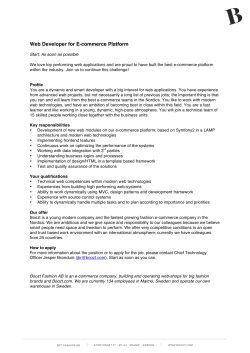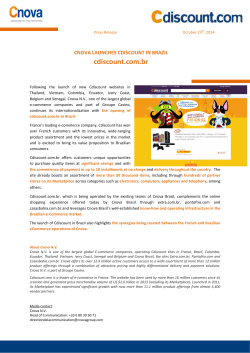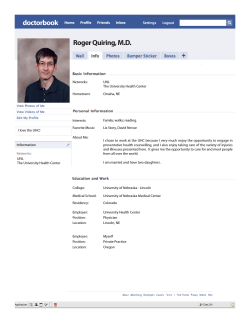
Starting a New Business - University of NebraskaâLincoln Extension
Institute of Agriculture and Natural Resources EC495 Starting a New Business: Pre-Launch Research Andrew Zimbroff, Extension Textile and Apparel Entrepreneurship Specialist Starting a business can be a challenging endeavor with many pitfalls. Lack of knowledge of business factors can lead to costly mistakes, and sometimes even business failure. Research performed beforehand can help address these risks, and increase the likelihood of business success and sustainability. This circular introduces various forms of research that can be undertaken before launching a business. It also provides examples of the research areas outlined. While this guide is designed to be undertaken before the launch of a new business, it can also be used to improve the business model of existing businesses. When planning a new business, it is recommended that you attempt to research all areas outlined in this paper. However, this might not be necessary or feasible for all new business concepts. Still, it is vital to research multiple topic areas in order to obtain a wide breadth of knowledge about the business you are attempting to launch or expand. Areas of Research Customer Research It is important to understand your customers and their needs, and customer research is often the most important area of investigation when planning a business. Strong knowledge of customers can facilitate increased sales con- version rates and improve marketing. It can also promote customer loyalty and repeat business. One of the most effective ways to study potential customers is to collect their input directly through a method known as primary research. Customer interviews, as well as other methods of directly engaging potential customers (see examples below), can serve as a source of valuable information and insights otherwise not attainable. When performing customer research, to obtain a diverse set of data, it is important to speak to multiple individuals. Additionally, to ensure responses are as informative as possible, look outside friends and family for interviews. Interview subjects should have similar demographic profiles as your targeted customer base. Lack of such demographic matching can seriously endanger the value of the data obtained. It is also possible to use secondary research to better understand your customer segment. Secondary research occurs when you do not do the research directly, but rely on a third party to collect and synthesize information for you. This can be advantageous, as many groups will have extensive resources or access to a certain user base you are trying to research. These groups often publish their findings that can be accessed through a Web search or through library resources. There are many business research groups and trade associations that publish research, and it is often straightforward to employ secondary sources for obtaining information about a business or customer segment you are trying to research. Extension is a Division of the Institute of Agriculture and Natural Resources at the University of Nebraska–Lincoln cooperating with the Counties and the United States Department of Agriculture. University of Nebraska–Lincoln Extension educational programs abide with the nondiscrimination policies of the University of Nebraska–Lincoln and the United States Department of Agriculture. © 2015, The Board of Regents of the University of Nebraska on behalf of the University of Nebraska–Lincoln Extension. All rights reserved. Examples of Primary and Secondary Research Primary and secondary research are both very useful tools when planning a new business. While either tactic can be used for any area of investigation, there are times when one tactic will be more readily implemented or more relevant than the other. Be sure to look at both approaches when performing preliminary business research. Examples of Primary Research include: Examples of Secondary Research include: •Interviews •Surveys • Focus groups • In-store customer observations • Reports from trade associations (i.e. National Corn Growers Association) • Government agency reports • Reports from market research companies (i.e. Gallup, Pew Foundation) • Information from an Extension office • Credible news and journal articles You will often find that neither primary nor secondary research alone will give you a comprehensive perspective, and a combination of both sources must be used. One final note to consider is that sometimes your customer (the person buying your product) and your end-user (the person using your product) will not be the same person. This can present a challenge when designing a product or service. Even if your product is perfect for its intended end-user, if you do not understand who is ultimately mak- ing the purchase, you will miss out on potential sales. On the other hand, if you focus only on the purchaser, you quickly alienate your user base. When this situation occurs, it is important to research both customers and end-users to give you a comprehensive understanding of your product sales and life cycle. Example #1: Different Users and Customers There are many instances when the end-user of a product is different from the customer who purchases the product or service. Table 1 gives examples of some of these instances: Table 1. Different Users and Customers Product User Customer Pet products Pets Pet owners Services for frequent business travellers Frequent business travellers Employer, clients Children’s products Children Parents, relatives, schools Facebook Profile holders Advertising agencies In the last example, users are able to make profiles and view content on Facebook for free. Advertising agencies are paying the website for the opportunity to advertise to these users. This customer and user configuration is common for many websites that offer content or services for free. 2 © The Board of Regents of the University of Nebraska. All rights reserved. Market Research It is important to have a strong understanding of the market you are entering as a business. This is a separate investigation from customer research, which focuses on individuals and what variables factor into their decision to purchase. Market research looks at total customers available and overall trends for this group. There are multiple types of market research that can be performed, which are described in detail below. Market Size — You want to be confident that the market you are entering is large enough to support and sustain a business. The term Total Addressable Market (TAM) is often used to estimate the maximum market a business can capture. Often times, secondary research will not give you an exact figure for a unique business’ market, and there are some straightforward techniques that can be used to estimate TAM. The first is called Top-Down Market Sizing. With this method, you start with a large market value (usually sourced from secondary research), and apply filters to focus in on the exact customer segment you are targeting. For example, if you are hoping to open a men’s athletic shoe store, you would start with the overall U.S. shoe market and apply filters for athletic shoes, gender, etc. It is important to apply all relevant filters into this analysis, otherwise you will have an artificially high estimate for TAM. An example of Top-Down Market Sizing is described in more detail in Table 2. Example #2: Top Down Market Sizing You are planning to open a store that sells athletic shoes to men. You are opening a brick-and-mortar store only, and your whole customer base must live within 25 miles of the store. After a study of nearby population centers, you conclude that 300,000 people live within this radius, and can be considered potential customers (Table 2). Table 2. Top-Down Market Sizing $20B/Year • Shoe Sales in the U.S. – $20B/Year $6B/Year • Athletic shoes – 30% of total U.S. shoe sales • 30%*$20B = $6B $4B/Year • Men's Athletic shoes – 66% of total athletic shoe sales • 66%*$6B = $4B $2B/Year • Men's Athletic Brick and Mortar Sales – 50% of total shoe sales. • 50%*$4B = $2B 2M/ Yr. • Total Addressable Market • U.S. Population ~ 300M people • Population within 25 miles – 300,000 • % of attainable market – 300,000/300M = .1% • .1%*$2B = $2M While $2 Million in Total Addressable Market might seem like a large amount, TAM represents total potential upside, and not what this business will capture. It is important to research competitors as well, to further understand how much of calculated TAM your business can capture. © The Board of Regents of the University of Nebraska. All rights reserved. 3 Another technique used for market sizing is called Bottom-Up Market Sizing. This method looks at projections and estimates for an individual customer or product, and rolls up all variables to estimate the TAM for a business. It is an effective technique to use when you have difficulty finding overall market information necessary for the Top-Down sizing technique. An example of Bottom-Up Market Sizing for an auto repair garage is shown in Table 3. Example #3: Bottom-Up Market Sizing You are planning on opening an auto repair garage in your hometown. After a demographic study of the town, you are fairly confident that there is enough demand for three full-time mechanics. Table 3. Bottom-Up Market Sizing Weekly jobs/ Mechanic Weekly Revenue/ Mechanic Weekly Business Revenue Total Addressable Market • Average time for repair job – 2 hours/job • Maximum jobs per week (assuming 40-hour work week) – 20 jobs/week • Predicted jobs/mechanic (assuming 90% occupancy) ~18 jobs/week • Revenue/repair job -- $100/job (average) • Revenue/mechanic -- $1800/mechanic/week • 3 Full-time mechanics • 3*$1800 = $5400/week • Business weeks of operation -- 50 weeks/year • Total addressable Market -- 50*$5400 = $270,000/year Note that Total Addressable Market in this case is an estimate for revenue and not profit. It does not take into account business expenses like rent, wages, etc. Market Growth Rate — A market that is growing is much easier to enter than one that is stagnant. A rapidly growing market is indicative of overall market health, with opportunities for new businesses to enter. It is important to consider overall economic factors when looking at growth rates, and growth rate of a market should be considered in relation to overall economic growth. For example, a market that is growing at 4% annually is not that auspicious if the general economy is growing at 5% per year. However, if overall economic growth is 1% per year, a market growth rate of 3% is excellent. 4 Market Segmentation — You will often notice that within certain industries, a particular market segment is growing particularly well, or provides a majority of all growth. It can be beneficial for a new business to identify and target these segments. Additionally, fledgling ventures often do not have the resources to pursue all market segments, and must pick one that is most promising, based on size and growth rates. Example #4 gives an example from e-commerce and online sales. © The Board of Regents of the University of Nebraska. All rights reserved. Example #4: E-Commerce Market Segments Not all sales channels are equal. In Q2 2014, Total Discretionary Retail Spending in the U.S. grew by 3%, compared to the same period in 2013. However, this number can be segmented further into brick-and-mortar and e-commerce (online) sales. As Figure A shows, the 13% Year over Year (Y/Y) growth for e-commerce is much higher than that of brick-and-mortar sales. Figure A. Q2 2014 Y/Y Retail Spending Growth by Channel Source: Dept. of Commerce, comScore e-Commerce & m-Commerce Measurement 14% 12% 10% 8% 6% 4% 2% 0% This still does not tell the full story however. E-Commerce can be divided into computer-based and mobilebased (smartphones and tablets), or m-commerce sales. If we look at Figure B, we can see m-commerce is growing over 4 times faster than computer commerce (though it only comprises 11% of all e-commerce sales, hence the overall growth rate). Total Discretionary Retail Brick and Mortar Sales E-Commerce Figure B. Q2 2014 Y/Y Retail Spending Growth by Channel Source: Dept. of Commerce, comScore e-Commerce & m-Commerce Measurement 50% 45% 40% 35% 30% 25% 20% 15% 10% 5% 0% E-Commerce Desktop M-Commerce Finally, we can look at different channels within mcommerce. Here in Figure C we can see that tablet-based sales are the largest driver of growth in this segment. Figure C. Q2 2014 Y/Y Retail Spending Growth by Channel The takeaway from the analysis above is that if you were selling a product in the future, it would be wise to consider tablets and m-commerce as a sales channel. Please note that this analysis is for example only, and sales channels will vary for different products and services. 80% Source: Dept. of Commerce, comScore e-Commerce & m-Commerce Measurement 70% 60% 50% 40% 30% 20% 10% 0% © The Board of Regents of the University of Nebraska. All rights reserved. M-Commerce Smartphone Tablet 5 Competitor Research Conclusions While competition can be a sign of demand of a product or service, you will be competing with these other entities for a finite number of customers. Some competitive landscapes can make starting a new business more difficult than others. When performing competitor research, you will be investigating the degree to which you can distinguish yourself sufficiently from competitors to create a sustainable business model. Business research can greatly help new ventures address risks, and increase potential for success. This research should be undertaken as soon as possible to avoid costly mistakes. This publication serves as a guide for early business planning by outlining customer, market, competitor, and barriers to entry research. When researching competitors, it can also be beneficial to consider your proposed business in relation to how it stacks up against competitors. Strong customer research can be very helpful for this. A strong business will be aware of competitors, customer’s needs, and have a plan for how to make their business better in the eyes of their customers. Thomas, I., Davie, W., & Weidenhamer, D. (2014, August 15). Quarterly Retail E-Commerce Sales 2nd Quarter 2014. Retrieved December 1, 2014, from http://www2. census.gov/retail/releases/historical/ecomm/14q2.pdf One thing to note is that often times a business will have competitors in completely separate industries. For example, if you are considering opening a movie theater, your competition would be all forms of entertainment available to your customer base, and not just other movie theaters. This can include local entertainment venues like arcades and bowling alleys. It will also include other movie-based options, like television, Netflix, and Redbox. References Lipsman, A. (2014, August 19). Q2 M-Commerce Explodes to 47% Y/Y Gain: What it Means for the Growth of Mobile. Retrieved December 1, 2014, from https://www. comscore.com/Insights/Blog/Q2-M-Commerce-Explodesto-47-YY-Gain-What-it-Means-for-the-Growth-ofMobile Barriers to Entry Barriers to entry are any obstacles that will get in the way of opening this new business. This can include startup costs for equipment or training, as well as additional research and development needs for a product or service. Regulations, and any special licensing required for the business you are planning, also falls into this category. While barriers to entry can be a hindrance for a business, they can also prevent new competitors from entering the same space. They can be advantageous for an established business to keep additional competitors from entering a market. You should think of barriers to entry not only in the context of your business, but also how they will affect new and potential competitors. 6 This publication has been peer reviewed. UNL Extension publications are available online at http://extension.unl.edu/publications. © The Board of Regents of the University of Nebraska. All rights reserved.
© Copyright 2025









